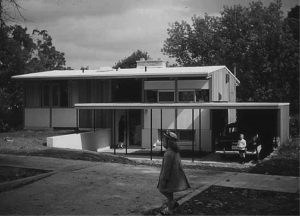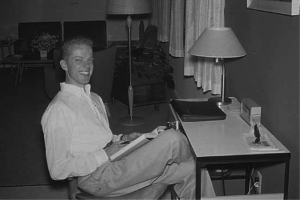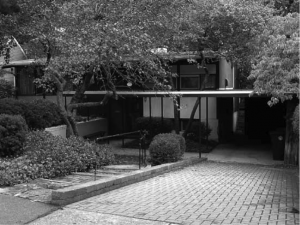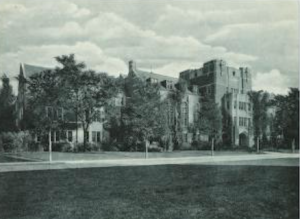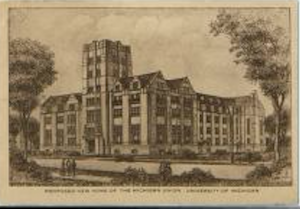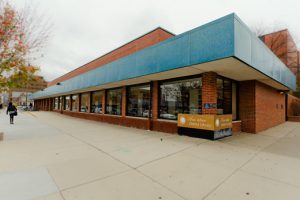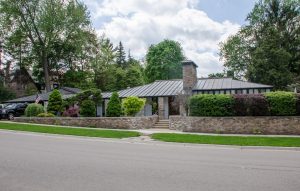Frank Lloyd Wright in Ann Arbor
Author: Grace Shackman
Thanks to Frank Lloyd Wright, Bill and Mary Palmer raised their family in a work of art.
On a Saturday morning a little over a year ago, a group that included prominent local architect Larry Brink; Doug Kelbaugh, dean of the U-M’s Taubman College of Architecture and Urban Planning; builder Bruce Niethammer; and George Colone, a heating specialist from Hutzel Plumbing & Heating, met to discuss a failing radiant heat system beneath the concrete floor of a fifty-year-old house. If it had been just any house, the solution would have been obvious: jackhammer the concrete and replace the pipes. But on hearing that suggestion, owner Mary Palmer recalls, “I nearly fainted. It wasn’t acceptable.” The reason so many people shared her concern was that the floor in question was designed by Frank Lloyd Wright.
The group worked out a solution that would preserve the part of the radiant system that still worked, about a third of the total. Hutzel would install a new boiler and radiators to heat the rest of the house–but would hide all the new components behind couches, inside cabinets, and under beds.
“ ‘Change’ is not in the vocabulary up there,” says Bruce Niethammer, who’s worked on the house since 1974.
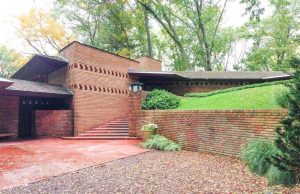 Larry Brink trained under Wright and has consulted on hundreds of Wright homes. “The Palmers maintained their house the best of all owners,” Brink says. “They took the best care of the house from day one.”
Larry Brink trained under Wright and has consulted on hundreds of Wright homes. “The Palmers maintained their house the best of all owners,” Brink says. “They took the best care of the house from day one.”
But while staying true to Wright and his principles, Mary and her husband, Bill, made the house their own, using it to express and enhance their interests in music, yoga, gardening, and art. “You take something, it becomes part of you, you become part of it,” explains the Palmers’ good friend Priscilla Neel, who is also an architect. “That’s what makes a building individual.”
It was quite a coup in 1950 to get the foremost architect of the century to design a house for a young couple in Ann Arbor. The Palmers had no “in” with Wright; they just asked him. But from meeting Mary Palmer fifty years later, it is clear why she would be drawn to Frank Lloyd Wright. A gracious lady with a hint of a southern accent (she grew up in North Carolina), her whole demeanor–her simple but elegant style of dress, her artistic sense, and her concern with doing things right–fit into a whole, like the perfectly integrated details of a Wright design.
Mary and Bill Palmer met as students at the U-M–Mary in music and Bill in economics. After graduation Bill was asked to stay and teach. In the early years of their marriage, the Palmers lived in an old farmhouse on Geddes, now the home of attorney Clan Crawford. The older women in the neighborhood befriended Mary. “They broke the rules about not inviting instructors to dinner parties,” she recalls. “These ladies knew gardens, literature–they were rich in what Ann Arbor had to offer.”
Elizabeth Inglis, who lived in the family estate on Highland (today the U-M’s Inglis House), was one of these remarkable women. One morning she phoned Mary to tell her that the road behind her house was being extended for building sites. Mary called Bill at work, and he came home at lunchtime. Mrs. Inglis, in gardening boots, showed them what she considered the best lot. “This is the most beautiful place in the city,” she told them. The young couple took her advice and bought both that lot and the one next to it–a total of one and a half acres of varied terrain.
Mary, a woman of wide intellectual interests, spent hours reading at the U-M’s architecture library while thinking about what kind of house to build on the site on Orchard Hills Drive. At the time she was very interested in antiques, so it might seem natural that she would have been drawn to a traditional style. But she was also very interested in Japan, one of Wright’s sources of inspiration. She had visited Japan, audited classes on Japanese art, and taken Japanese language classes.
Mary’s reading led her to Wright. The architect was then eighty-three years old but still active. Hoping to see one of his homes for herself, Mary telephoned Gregor and Elizabeth Affleck, who lived in a 1941 Wright house in Bloomfield Hills. The Afflecks responded by inviting the Palmers to dinner. Bill and Mary drove to Bloomfield Hills on a frigid February day. “We had an ‘experience,’ ” Mary recalls. “And they had as much of an experience showing it to us as we had. How it felt to be in one of Mr. Wright’s buildings opened up to me!”
On the way home Mary said to Bill, “Let’s see if we can get Mr. Wright.” Bill agreed it was worth a try. He thought that the project might appeal to Wright: Ann Arbor, despite the presence of the U-M architecture school, had no example of Wright’s work.
Mary wrote Wright a letter that concluded, “I hope you will design our house and we will not have to go to a lesser architect.” Her mother, who lived in Raleigh, North Carolina, had told her that Wright was going to be lecturing at North Carolina State, so Mary suggested in her letter that they could meet there. Wright agreed.
The Palmers attended the lecture and then gave Wright a topographic map of their property. “He opened it and looked at it,” Mary recalls. “Then he looked up, rolled it back up, and said, ‘I’ll design your house.’ It was that simple.” Not known for false modesty, Wright told them, “Wouldn’t it be wonderful for your children to grow up in one of my houses?”
Thinking back, Mary Palmer suspects Wright accepted the commission because “he saw a young couple who were really going to build–who wouldn’t back out. There was a big falloff of clients, many who went to him for designs never built.”
Some months later, the Palmers picked up the house plans at Taliesin, Wright’s home and studio in Spring Green, Wisconsin. Wright delivered the plans and left the Palmers alone to review them. The most striking detail was that the design was made up of equilateral triangles instead of the rectangles of a traditional house.
“I must say when we looked at the triangular module it was a surprise,” Mary recalls, “because we didn’t ask for it. But I had some background, because I was familiar with the Anthony house in Benton Harbor.” As he had with the Anthony house, Wright had produced a floor plan without a single conventional ninety-degree angle–every angle is either 60 or 120 degrees.
Although familiar with architectural styles, the Palmers had never seen preliminary plans and were not quite sure how to interpret them. When Wright returned to the room after about fifteen minutes, he told them to take the plans home and think about it. They showed the plans to Mary’s family in North Carolina, who also found themselves at sea. After a month or two of pondering, they got back to Wright and told him the house was too small.
Mary expected some resistance, because “the plan looked so perfect as it was,” but Wright replied that he was just trying to keep costs down for their sake. “He enlarged the house with no trouble,” she recalls. Wright made the bedrooms several modules larger, added a mud room and pantry to free up space in the kitchen, and put a study for Bill at the back of the house.
The plans, now kept at the U-M’s Bentley Historical Library, detail not only the building materials but also the design and placement of the furniture (most of it built in) and even the color scheme–Wright’s signature “Cherokee red.” For the exterior, the architect specified red tidewater cypress, sand-molded brick, and a matching perforated concrete block. Part of the roof would be flat; the sloping portion would have red cedar shingles. Although Wright was not big on basements, he included a small utility basement under the kitchen. The rest of the house would be constructed on a concrete slab finished with a red glaze coat called “colorundrum.” (Maintaining the slab’s appearance was a major goal of the recent heating repair.)
The Palmers hired Erwin Niethammer, Bruce’s uncle, to build the house. “He was one of the best builders around,” recalls local architect David Osler. Niethammer was also well suited to the job because he was not easily intimidated–“He didn’t take nonsense from anyone,” according to Osler.
Mary Palmer recalls that Niethammer was “receptive to the unusual. He looked at the plans and said he’d never seen anything like it, but thought he could build the house.” He also told her they were the most “beautiful set of plans he’d ever worked with.”
Gathering the materials was probably the biggest challenge. The cypress had to be specially ordered, the blocks specially fired. Working with Fingerle Lumber and Niethammer, the Palmers found the best craftsmen in the area to make the built-in furniture.
Bruce Niethammer was only four when the house was being built, but he still has a vivid memory of a Sunday drive his family took to the site. “We saw the house up on the hill and piles of dirt and lumber,” Niethammer recalls.
“It was an event,” recalls Priscilla Neel, who visited the site regularly during construction. So did Bob Metcalf, a U-M architecture prof and future dean. “It was a unique experience for a town to have a Frank Lloyd Wright house,” Metcalf remembers. David Osler, too, was a frequent visitor. John Howe, the head draftsman at Taliesin, came by periodically to make sure things were going all right, but so far as these sidewalk superintendents could tell, Niethammer seemed to do fine on his own.
Of course the Palmers, living just a few blocks away, also viewed the progress of the house. “When it was being constructed, we all went out to see it over and over,” recalls the Palmers’ daughter, Mary Louise Dunn, then about ten. “We saw it was going to be marvelous.”
Mary Palmer says she left most of the decisions about the house to the architect. “Mr. Wright was not autocratic–just sure of himself,” she recalls. “He would say ‘I don’t think you’d like . . . ’–and he was always right.”
The Palmers moved into the house shortly before Christmas 1952. The large triangular living area at the center of the home was ideal both for family life and for entertaining. It has windows on two of its three sides, and a pyramidal ceiling formed by three triangular sections.
The room is still arranged exactly as it was in Wright’s plans half a century ago, with a grand piano as the focal point. People sitting on the built-in couch, a parallelogram, look toward the piano and onto the grounds beyond. Between the couch and piano on the right is a large brick fireplace. On the left side of the room are the Wright-designed dining table and chairs, and tucked behind them is the kitchen, separated from the living area by specially manufactured perforated blocks.
The ceiling in the sleeping wing is much lower, as is common in Wright houses. (The architect was a short man, and some have speculated that he would have made the rooms higher had he been taller.) A more pedestrian architect might have switched to a conventional design for this less visible area, but Wright continued his triangular pattern, even designing hexagonal built-in beds in the master bedroom and children’s rooms. (Mary Palmer used to have sheets specially made but now just folds them under.) The house is situated so that the bedrooms get morning sun.
The living room’s unexpected angles and peaked ceiling, the sun pouring in the large windows, the view of the landscaped backyard–all combine to create a breathtaking experience. After almost fifty years, Mary Palmer says, she is still continually amazed by the beauty of the house.
When the Palmers first moved in, their two children, Mary Louise and Adrian, were still young, and they tried to lead as normal a family life as possible. “We used the house,” says Mary Louise Dunn. Asked whether it was hard to live there, Dunn replies, “There was always a standard of how to treat the house–higher than most, imposed by the house. There was no basement rec room, no place that wasn’t absolutely beautiful.” But, she adds, “the payoff, if we couldn’t do anything like everyone else, was that it was so special.” The semirural location (it was outside the city limits until 1999) also allowed activities that couldn’t be done in a more urban setting, such as taking Sassafras, the neighbors’ donkey, down to Nichols Arboretum to ride. When Dunn was a teenager, she had parties like other kids, rolling up the rugs and dancing to rock ’n’ roll.
After living in the house a few years, the Palmers put in a terrace off the living room. Wright had said that the terrace, which was part of his original plan, would be a good place to have weddings, and in time both Mary Louise and Adrian would be married there.
In 1964, after a visit to Japan, the Palmers built a Japanese garden house, which they used as a guest house and meditation area. By then Wright was dead, but Taliesin’s John Howe designed it in the same style as the house, complete with a three-section pyramidal ceiling. The last major change was a garden wall that Brink executed, using Wright’s design with a few necessary modifications.
Elizabeth Inglis suggested that the Palmers wait a year before starting to landscape, so that they could see what they had. Since the site was once an orchard, there were some beautiful trees on the lot, including apple trees that went back several decades. When they were ready to begin, Inglis sent her own gardener, Walter Stampfli, over with flats of pachysandra and euonymus. The garden turned into a lifetime passion for both Palmers. “It was a real collaboration between Mother and Father,” recalls Dunn. “Mother was the artistic one. She gave unstinting consideration to the whole garden, considering it from every angle.” Of her father she says, “He was a great gardener, actually planting, appreciating plants, doing cuttings, watering, fertilizing.” The garden, which even today is being further refined, follows the site’s natural contours and uses a limited palette of plant materials. Although formed with great art, it looks utterly natural.
Mr. Wright, as Mary Palmer calls him to this day, did not see the house until it was finished. She remembers his first visit: “He didn’t look at the house. He went right to the piano and sat down and played.” Asked what he played, she replies, “Something he composed extemporaneously.” Music was a shared interest for the architect and his clients: Wright once told Mary, “If you didn’t like music, you wouldn’t like my architecture.” Wright, whose father had been a music teacher before studying for the ministry, often compared his architecture to music.
Wright stayed overnight with the Palmers in 1958. Invited by the U-M architecture students to give a lecture, he agreed on the condition that he would talk only to them and not to their professors. Wright slept in one of the Palmers’ hexagonal beds and had oatmeal for breakfast.
On an earlier visit to Michigan, in 1954, when he was to lecture at the Masonic Temple in Detroit, he stayed with the Afflecks but came to the Palmers’ for dinner. Gil Ross, a U-M faculty member and the first violinist of the university-based Stanley Quartet, was a close friend of the Palmers, so they asked him if the quartet would perform for Wright. Mary recalls that they opened with a Haydn quartet. When the first movement ended, Wright stopped them, saying something was wrong. Everyone looked uncomfortable–the Stanley Quartet were first-rate musicians. Then Wright explained that their playing was fine but that their location bothered him. He walked over and helped them move their music stands and chairs between two piers leading out to the terrace, where he thought the music would sound better.
Many of the Palmers’ friends were people connected with music. “I first knew the music faculty as teachers, then as friends. It was the beginning of all our friendships,” recalls Mary. Both Palmers were active in the University Musical Society and the Ann Arbor Symphony Orchestra and often entertained musical luminaries in their house. Dunn recalls meeting such performers as Lena Horne and Frederica von Stade.
The Palmers’ yearly caroling party is also fondly remembered by those who attended. “About twenty families would sing and then eat. Mary’s was a perfect place for it because of the sensational acoustics,” recalls publisher Phil Power, whose parents, Eugene and Sadie Power, were good friends of the Palmers. Dunn recalls that at Christmastime her mother would bring out a special set of Welsh bells, spanning two octaves, to add to the music from the piano.
Mary’s interest in music segued serendipitously into another interest: yoga. Bill Palmer got to know many foreign students in college, and Mary first heard of yoga through his Indian friends. When she went to the Y to sign up for her first yoga class, she was pleasantly surprised to run into her good friend Priscilla Neel putting her name down for the same class.
Palmer and Neel’s original teacher was an American, as was her replacement. Both teachers did their best, but in retrospect, Neel says, the exercises were “by rote-more like calisthenics.” When the second teacher was leaving, she told Palmer and Neel that they should take over. The second teacher had encouraged them to read some of the yoga literature, including B. K. S. Iyengar’s Light on Yoga, which came out in 1966 with a foreword by violinist Yehudi Menuhin.
“Of all the artists who come to Ann Arbor, the one I’d really like to meet is Mr. Menuhin,” Mary Palmer told Alva Sink, whose husband, Charles, then headed the University Musical Society. Later, when Menuhin came for a concert, the Sinks invited the Palmers to a small party afterward. Mary took Iyengar’s book with her and told Menuhin that she wanted to go to India and study with the author. “Without batting an eye, he said, ‘You must go,’ ” she recalls. “He was pleased someone knew about this dimension of his life.” When Bill was on sabbatical, she traveled to India, carrying a letter of introduction from Menuhin, and met with Iyengar in Poona.
“She came back very enthusiastic,” recalls Neel. The women and a few friends began to practice yoga at the Palmers’ house. “One of us would read [Iyengar’s book] on tape. Then we’d put it on and learn the positions,” recalls Neel. In 1973 they convinced the Y to sponsor Iyengar’s first visit to the United States. “Then he came and showed us how to really do it,” Neel recalls. For the next decade, until he retired, Iyengar visited Ann Arbor regularly. After coming to Ann Arbor, he was invited to cities all around the country and attracted students to India, where Palmer and Neel helped him open a yoga institute. “Mary always entertained when Iyengar was in town,” Neel recalls. “He’d stay at her house.”
Iyengar was only one of many guests over the years, some drawn by fascination with Wright’s architecture, others by the warmth of the Palmers and their shared interests. “Mary’s an incredibly gracious hostess,” says Anne Glendon. “The house and her intellectual interests are a unified whole.”
Glendon recalls a spring party to honor Carl St. Clair, then conductor of the Ann Arbor Symphony, when “the grounds were beautiful with daffodils.” David Osler, whose wife, Connie, started the docent program at the U-M Museum of Art, remembers a gathering at the Palmers’ in honor of Marshall Wu, the curator of Asian art. “Magic,” says Osler. “It was a warm fall evening. The moon was out. Everything was waxed and polished.” One party that stands out in Mary’s mind is a dinner she gave for Yehudi Menuhin. “He liked to sit on the floor, so we had tables sitting on the floor with white tablecloths.”
Different visitors respond to different aspects of the house. Architect Ralph Youngren, impressed to find all the original furniture still in place, was intrigued by “the odd-shaped drawers and dressers” and by the Palmers’ attention to detail, down to the special red gravel they ordered for the driveway. Ann Arbor Building Department head Larry Pickel was struck by how the hexagonal shape of the beds made it impossible to put pillows next to each other.
“I was fascinated by being in a Frank Lloyd Wright house,” says retired U-M surgeon Herb Sloan. “I’d been in Wright houses that were museums, but not one where someone lived.” Judy Dow Rumelhart, who used to live across the street, remembers how she “adored going out in the teahouse. It’s a romantic house–another world.” Mary Louise Dunn says that even her teenage friends responded to the architecture: “You couldn’t be human and not recognize it’s unique.”
Although the Palmers were generous in sharing their house, Bill and Mary also guarded their privacy. They opened their home to the general public on only two occasions. In the 1980s they allowed it to be shown on the Women’s City Club Tour, helping to make that year’s tour the most lucrative ever. A few years ago Mary opened her house for a UMS fund-raiser that sold out instantly.
Bill Palmer died in November 2000. Mary is still enjoying the house. It’s Wright’s only house in Ann Arbor–unless one counts a house on Holden Drive that was built in 1979, twenty years after Wright’s death, from plans he drew–and living in one of his buildings is a continual balancing act. “All owners of Frank Lloyd Wright houses are plagued by curious people,” says Brink. On a recent visit to the house, while looking out a window with Mary Palmer, I saw a car slow down and creep along as it passed the house. Mary told me that happened all the time. As if anticipating this kind of attention, Wright designed the house for maximum privacy. Not much can be seen from the road, and what is in view tells very little about the delights inside and out back.
“She was the perfect client for Mr. Wright,” says Bruce Niethammer of Mary Palmer. Even after Wright’s death in 1959, the Palmers kept the house as close as possible to his original conception. At first Mary worked closely with John Howe and Larry Brink; Howe has since died, but Mary still works with Brink. For instance, Wright designed chairs for the living room, but the Palmers used some Scandinavian chairs instead. Mary was never satisfied with them, and turned to Brink for help. Using Wright’s original design, he figured out how to make Wright’s chairs and had them fabricated by Phipps of Port Huron.
And of course, it wouldn’t be a Frank Lloyd Wright house without a challenging roof–but again Brink, with Niethammer executing the plans, has devised improvements that keep the look of the house intact while keeping the Palmers dry. “Mr. Wright lived on the edge in his architecture,” explains Niethammer. “Low sloping roofs are not really suited for cedar shingles. It’s too shady–too flat. It’s pretty, but it holds moisture, because the water doesn’t run off.” Close attention to maintenance has saved the sloping roof, while the original tar sections of the flat roof have been replaced with lead-coated tin.
Palmer, still as enamored of Wright as ever, bristles at any criticisms, saying, “Everything you hear about Mr. Wright has two sides.” On my original visit she had me move from the couch to the Wright-designed chairs to show me how comfortable they were, and later she had me make the same test with the dining room chairs. She is appalled that people will say to her, “But do you really live here?”–or, worse, “I think it’s an interesting house, but I certainly wouldn’t want to live here.” She is unambiguously not in agreement: “I can’t imagine having something so fulfilling in so many ways–visually, the tremendous serenity, the fantastic drama.”
Beyond its own pleasures, the house has given the Palmers opportunities to meet fascinating people, many of whom ended up as friends. “Anyone interested in architecture comes to Mary’s,” says Brink. Bob Metcalf recalls a big Wright symposium in the 1970s attended by all the leading Wright scholars. In honor of the event, architecture students painted a 120-foot canvas of a building Wright designed but never built for a site in Kansas, and hung the canvas from Burton Tower. The event ended with a big party at the Palmers’ for all the participants. More recently a delegation of Japanese architects, led by Taliesin-trained Raco Indo, visited the house. E. Fay Jones, a Taliesin-trained architect best known for his Thorncrown Chapel in Arkansas, and the celebrated Indian architect Charles Correa, a U-M architecture graduate, have also visited.
“As a group, musicians seem to seek out the house as well as architects,” Mary says, remembering the time she got to hear Hephzibah Menuhin, Yehudi’s sister, play their grand piano. Menuhin was staying at Inglis House before a concert, and Gail Rector, then head of the University Musical Society, asked the Palmers whether Menuhin could practice on their piano. Menuhin came over and ran through her entire program. Asked if she listened, Mary replies, “Of course.”
More recently, the house gave her the opportunity to befriend members of the Royal Shakespeare Company, who gave awe-inspiring performances of Henry VI and Richard III under UMS auspices last March. Current UMS president Ken Fischer is a great friend and admirer of Mary Palmer, and when a group from RSC visited Ann Arbor a year before the performances to check out the facilities, Fischer took them to see the Palmers’ house. They raved about the experience, and when the whole troupe came the next year, another visit was high on their wish list. Mary responded by inviting all of the actors to tea–served on the “India Tree” Spode china that Wright had personally selected for the house.
Mary gained more than fond memories from the RSC visit. She actually acquired an addition to her house: a piece of “sculpture” for her garden. Tom Piper, an RSC set designer, had been among the first group to visit. When he returned the next year, Mary took him around the garden and said, winking, “Instead of charging, I ask advice. What’s missing is sculpture. I’ve been looking all my life, but nothing is right.” After discussing the question with the rest of the RSC group, Piper suggested they give her one of the ladders from the set.
Contacted by e-mail, Piper explains, “I wished there was a way to thank her for her hospitality and jokingly suggested that she should have the whole ‘hell mouth’ set in the garden. That seemed a little impractical!!! So I thought she should have one of the metal ladders as a memento of the play. Frank Lloyd Wright is a great hero of mine, and it’s wonderful to think of a bit of my set becoming a sculpture in the garden of one of his finest houses!”
The ladder, visible from the living room, is casually but artfully placed against a tree. As it rusts, it will fit even better into the ensemble of landscaping and house. It’s just the latest development in the continuing melding of Wright’s architecture with the Palmers’ interests and the greater community.
In retrospect, Mary Palmer says, “What attracted me to Mr. Wright was not pictures of the houses, not visiting other houses, but his philosophy that came into the house. It widened the whole reaction–how to live in the house, incorporating the landscape, the materials, the site–the whole big picture.”

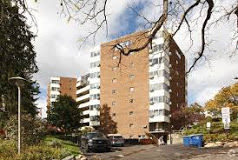 Lurie Terrace, a residence for active seniors of moderate means, was a real groundbreaker when it was built fifty years ago. “There were none [like it] to the best of our knowledge” recalls Bob Chance, one of the four architects who worked on it. The designers had no template to follow, just organizer Shata Ling’s vision.
Lurie Terrace, a residence for active seniors of moderate means, was a real groundbreaker when it was built fifty years ago. “There were none [like it] to the best of our knowledge” recalls Bob Chance, one of the four architects who worked on it. The designers had no template to follow, just organizer Shata Ling’s vision.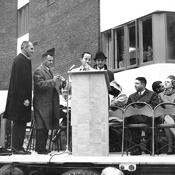 The official opening was October 9, 1965 – a day so cold and raw that some of the participants watched from inside. The program booklet included a quote from Donahue, from whom Ling had gotten many of her ideas: “Not only is this a ‘break-through’ in retirement housing for middle-income people, but Lurie Terrace represents the practical application of U-M’s many years of work and study.” The New York Times published an article about Lurie Terrace, and in the early years there were visitors from around the world who wanted to learn from its example.
The official opening was October 9, 1965 – a day so cold and raw that some of the participants watched from inside. The program booklet included a quote from Donahue, from whom Ling had gotten many of her ideas: “Not only is this a ‘break-through’ in retirement housing for middle-income people, but Lurie Terrace represents the practical application of U-M’s many years of work and study.” The New York Times published an article about Lurie Terrace, and in the early years there were visitors from around the world who wanted to learn from its example.
